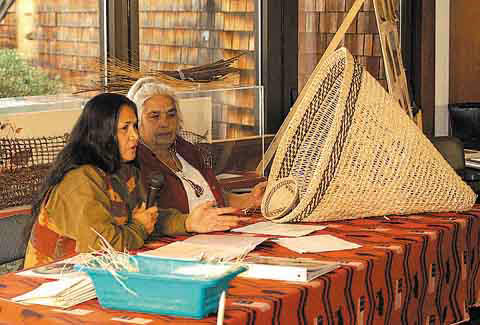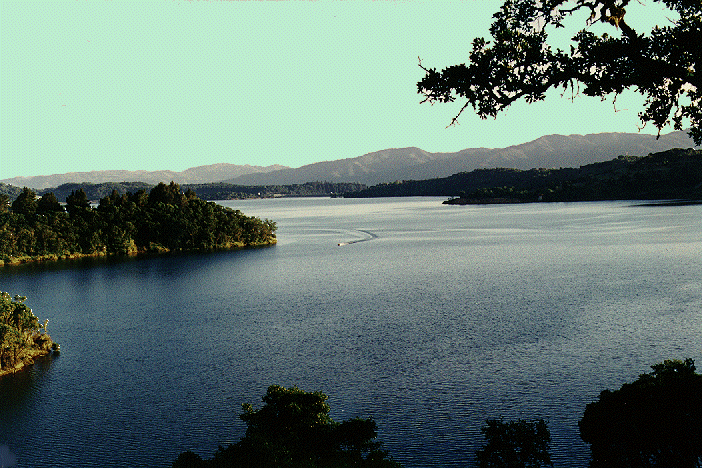|
|
Canku Ota |
|
|
(Many Paths) |
||
|
An Online Newsletter Celebrating Native America |
||
|
January 25, 2003 - Issue 79 |
||
|
|
||
|
Keeping a Tradition Alive |
||
|
by LeeAnn Lambert The
Ukiah Daily Journal
|
||
|
|
|
Organized by the Suscol Intertribal Council, the conference brought together Native American basket makers and others interested in creating, improving or restoring areas were plants like sedge, redbud, dogbane and more are grown and are needed to make the baskets. There was also discussion by participants about preserving the knowledge and ability to gather these materials and make baskets plus carrying on the legacy by teaching others. "I didn't know how bad it was that we didn't have any weavers," said Luwana Quitiquit, who was a presenter during one of the panel discussions Saturday at Lake Mendocino's Pomo Information Center and is a member of the Robinson Rancheria working to preserve and teach others the history, culture and knowledge of Pomo basket making. A retired social worker, Quitiquit has taken on this challenge and has found funding to help teach members of her tribe, and other tribes, basket making. "I took this on, and I'm not going to quit," she said. "We really feel we can do something here," Quitiquit continued, as she asked those in attendance to help find basket weavers who would be willing to commit to increasing their own skills and then to share and teach what they know to other Native Americans. Adding that basket making isn't just for women, Quitiquit said she has "taught a lot of boys to do Pomo baby cribs. I don't think a lot of people know that the men made the baby baskets." She encouraged those there to share their knowledge of gathering materials and basket weaving with others and also to glean cultural information from the elders of the different tribes before they are gone about how it should be done correctly. Speaking along with Quitiquit on the panel was Karen Whipple, a basket weaver from Round Valley who began weaving in the 1970s as an adult. "I never made a basket," said Whipple, "but I just decided I would go ahead and try." Thirty years later, she now meets each week with a group of weavers up in Round Valley and she also spends two nights a week teaching others what she has learned. Whipple said she's too busy to devote any more time right now to basket making because she works and is raising a 14-year-old grandson. But four years from now when the grandson is grown up, she said, "I'm dedicating my life to this." "I'm not a teacher," Whipple maintained, "but I have showed others how to do a coil basket." And if one person will teach one other person, and so on, she said, "pretty soon we're going to have good leaders" who will be able to carry on the culture by teaching others about basket making. Encouraging others to try their hand at weaving, Whipple advised that while someone's "first basket won't be great by the tenth one, you will be good." Additionally, Whipple talked about the need to cultivate areas where basket-making materials can be grown and more easily collected. For example, while some materials grow in Round Valley along the creeks, she said, "it's all tangled." She's asked the local tribal organization to help, but she needs to find the time to go out with the crews to show them how to prune the overgrown areas. Furthermore, she said that "the elderly can't climb up and down the canyons anymore," so they need the help of younger folks to gather the needed supplies. "I hope we can get our materials to the point were we want them," Whipple said. Speaking about both cultivation of materials and basket weaving, she added that Native Americans "are going forward, but it's awful slow." But she was confident that if her generation doesn't succeed at accomplishing these goals, "our grandchildren will." Another panel participant Saturday was an expert basket weaver and teacher named Ennis Peck who learned from his grandparents the culture and knowledge needed to do traditional weaving. "I feel very blessed that I had a grandmother and grandfather that taught me the old ways," Peck told conferencegoers. "It was just a way of life for them." Peck also learned the names of the different basket-making materials "in my language," and is able to share that knowledge with others. Bringing up another issue discussed Saturday; Peck said when it came to putting a price on the baskets, "I wised up. I was selling my baskets too low." Especially when Peck found out the baskets were being resold. "I don't like to put a price on it," Peck said. "I just enjoy doing it." But a person in the audience told Peck that while it may be hard to put a price on something many consider to be a personal and spiritual thing to do it must be done. "I think it's hard for our people to put dollar signs on things," she said, "that's not our way. But we need to do it." Quitiquit responded that she hoped part of what they can do together is to study how to market their basketry, which not only takes time to produce but also it takes time to gather the supplies and prepare them for weaving. "Part of the project we're working on is to find out what is fair," she said. Another issue several weavers brought up is the difficulty they have in finding pesticide-free plants to collect, since many of the most accessible gathering areas are along roadways where frequently Cal Trans crews spray or cut vegetation back.
|
|
|
||
|
|
||
| Canku Ota is a free Newsletter celebrating Native America, its traditions and accomplishments . We do not provide subscriber or visitor names to anyone. Some articles presented in Canku Ota may contain copyright material. We have received appropriate permissions for republishing any articles. Material appearing here is distributed without profit or monetary gain to those who have expressed an interest. This is in accordance with Title 17 U.S.C. section 107. | ||
|
Canku Ota is a copyright © 2000, 2001, 2002, 2003 of Vicki Lockard and Paul Barry. |
||
 |
 |
|
|
The "Canku Ota - A Newsletter Celebrating Native America" web site and its design is the |
||
|
Copyright © 1999, 2000, 2001, 2002, 2003 of Paul C. Barry. |
||
|
All Rights Reserved. |
||
 Learning
how to cultivate and collect the sometimes hard to get natural products
used to make traditional Pomo baskets in Northern California was a goal
of a two-day conference put on over the weekend at Lake Mendocino and
at the Robinson Rancheria in Lake County.
Learning
how to cultivate and collect the sometimes hard to get natural products
used to make traditional Pomo baskets in Northern California was a goal
of a two-day conference put on over the weekend at Lake Mendocino and
at the Robinson Rancheria in Lake County.